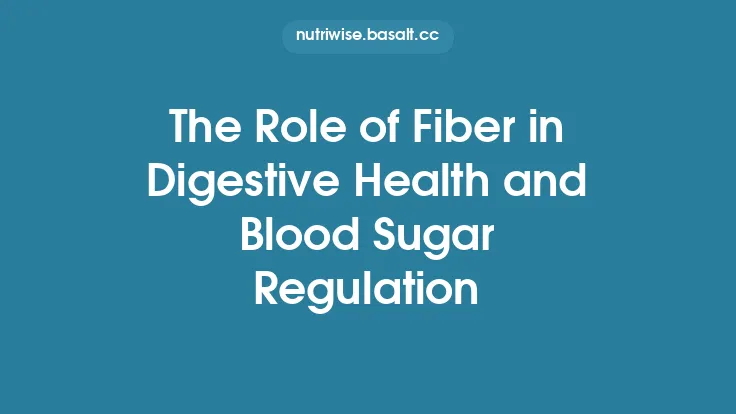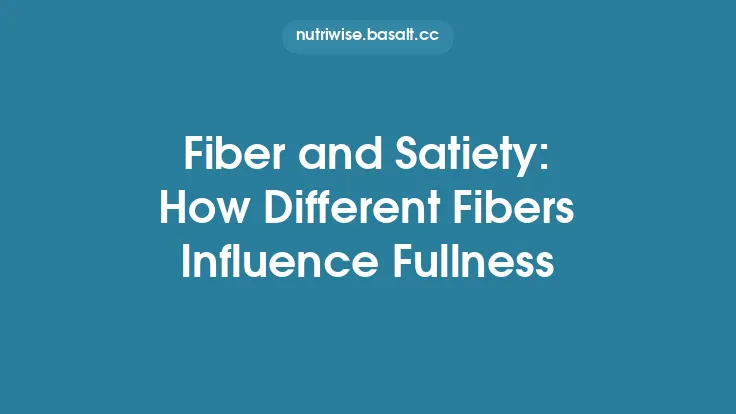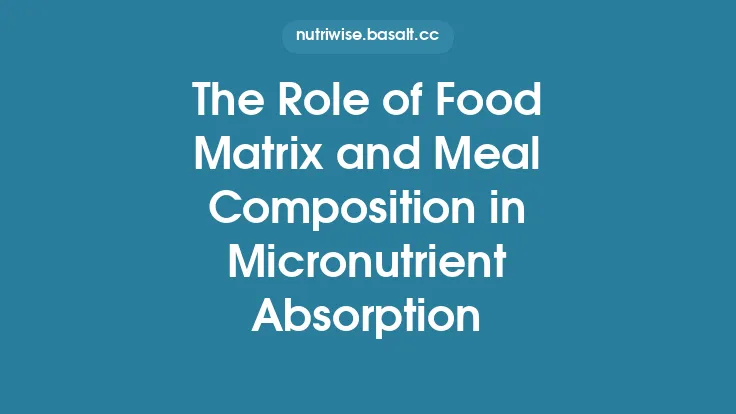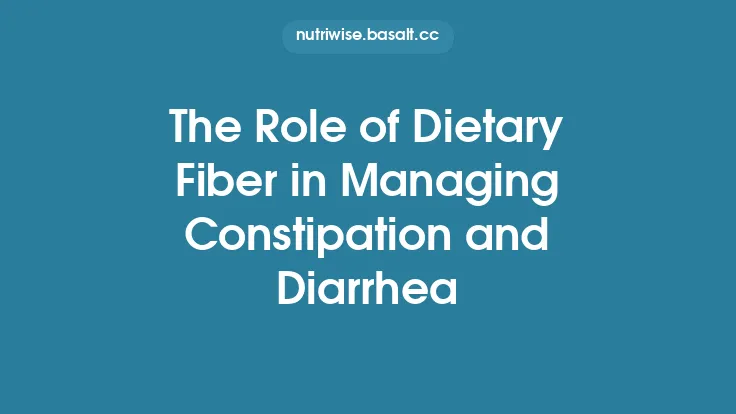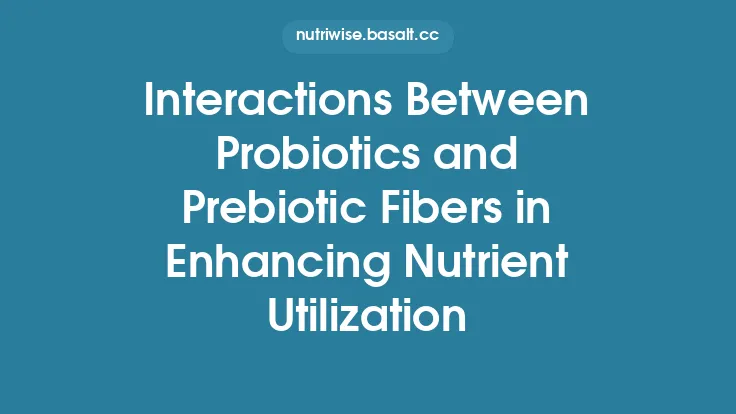Viscous fibers are a distinct group of dietary polysaccharides that possess the remarkable ability to absorb water and form thick, gel‑like solutions in the gastrointestinal tract. This physicochemical property sets them apart from other fiber types and underlies a suite of effects that modulate the pace at which food moves through the digestive system. By creating a viscous matrix, these fibers can slow gastric emptying, impede the diffusion of digestive enzymes, and alter the microenvironment in which nutrients are absorbed. The result is a more gradual release of glucose into the bloodstream, a tempered uptake of dietary lipids, and a cascade of downstream metabolic benefits. Understanding the structural features that confer viscosity, the precise mechanisms by which these fibers act, and the practical ways to incorporate them into the diet is essential for nutrition professionals, food scientists, and anyone interested in optimizing digestive health.
Molecular Basis of Viscosity
Viscosity arises from the interaction between the polymeric backbone of a fiber and water molecules. Several molecular characteristics dictate the extent of this interaction:
| Feature | Effect on Viscosity |
|---|---|
| Molecular weight (MW) | Higher MW polymers create longer chains that entangle more readily, producing thicker gels. |
| Degree of polymerization (DP) | A greater number of monomer units increases chain length, enhancing water‑binding capacity. |
| Branching pattern | Highly branched structures (e.g., β‑glucan) expose more hydroxyl groups to water, boosting hydration. |
| Charge density | Polysaccharides bearing charged groups (e.g., carboxylates in pectin) attract water via electrostatic forces, increasing swelling. |
| Solubility in physiological pH | Fibers that remain soluble across the pH range of the stomach (≈pH 1–3) and small intestine (≈pH 6–7) maintain their gel‑forming ability throughout digestion. |
The combination of these attributes determines the viscosimetric profile of a fiber, typically measured as centipoise (cP) at a defined shear rate and temperature. For instance, guar gum (galactomannan) can reach viscosities exceeding 10,000 cP at 1 % w/v in water, whereas a less branched soluble fiber like inulin may only achieve a few hundred cP under the same conditions.
Mechanisms by Which Viscous Fibers Slow Digestion
- Delayed Gastric Emptying
The gel formed in the stomach adds bulk and increases the viscosity of gastric contents. Mechanoreceptors in the antrum sense this heightened viscosity, triggering feedback loops that slow the pyloric outflow. Studies using scintigraphic imaging have shown that meals enriched with 5 g of psyllium can extend gastric residence time by 30–45 minutes compared with control meals.
- Reduced Enzyme–Substrate Contact
Digestive enzymes such as α‑amylase, lipase, and proteases rely on diffusion to encounter their substrates. A viscous matrix creates a diffusion barrier, effectively lowering the local concentration of enzymes around starch granules or lipid droplets. This kinetic limitation slows the rate of hydrolysis, leading to a more gradual appearance of glucose and fatty acids in the lumen.
- Modulation of Micelle Formation
In the small intestine, bile salts emulsify dietary lipids into micelles, which are then absorbed by enterocytes. Viscous fibers can sequester bile salts within the gel network, reducing the efficiency of micelle formation. Consequently, the rate of lipid absorption is attenuated, and a portion of bile salts is excreted, contributing to cholesterol homeostasis.
- Altered Intestinal Transit Velocity
While the primary focus of viscous fibers is on the early phases of digestion, the gel persists into the distal small intestine, where it can modestly slow peristaltic wave propagation. This extended transit time provides a longer window for nutrient absorption but does so in a controlled, stepwise manner rather than a rapid surge.
- Barrier to Nutrient Diffusion Across the Mucosa
The mucosal surface is lined with a glycocalyx that already presents a diffusion barrier. The additional viscous layer can further limit the rate at which monosaccharides and fatty acids reach the brush‑border transporters, thereby smoothing postprandial nutrient spikes.
Key Viscous Fiber Sources in the Diet
| Fiber | Primary Food Sources | Typical Viscosity (1 % w/v, 25 °C) |
|---|---|---|
| β‑Glucan | Oats, barley, certain mushrooms | 1,500–3,000 cP |
| Psyllium husk (Arabinoxylan) | Psyllium seed husks (Metamucil®) | 5,000–10,000 cP |
| Pectin | Citrus peel, apple pomace, quince | 2,000–4,000 cP |
| Guar gum | Guar beans (Cyamopsis tetragonoloba) | 8,000–12,000 cP |
| Locust bean gum (Carob gum) | Carob tree seeds | 3,000–6,000 cP |
| Konjac glucomannan | Konjac root (Amorphophallus konjac) | 10,000–15,000 cP |
| Agar & Carrageenan | Red algae (Gelidium, Gracilaria) | 4,000–9,000 cP |
These fibers differ not only in their source but also in the temperature‑dependent rheology of their gels. For example, agar forms a firm gel at temperatures below 40 °C, whereas guar gum remains fluidly viscous even at higher temperatures, making it suitable for hot soups and sauces.
Impact on Carbohydrate Digestion and Glycemic Response
The slowing of carbohydrate digestion is perhaps the most widely studied outcome of viscous fiber consumption. By limiting the access of α‑amylase to starch granules, the rate of maltose and glucose production is reduced. This effect translates into a lower postprandial glycemic index (GI) for meals that contain viscous fibers.
- Quantitative evidence: In a crossover trial, adding 3 g of oat β‑glucan to a white bread meal reduced the incremental area under the glucose curve (iAUC) by ~20 % compared with the control.
- Mechanistic nuance: The gel’s viscosity also slows glucose diffusion across the intestinal epithelium, further dampening the rise in blood glucose.
- Clinical relevance: For individuals with impaired glucose tolerance, regular intake of viscous fibers (≥5 g/day) has been associated with modest improvements in HbA1c (0.3–0.5 % reduction) over 12 weeks.
Influence on Lipid Digestion and Cholesterol Metabolism
Viscous fibers exert a dual effect on lipid handling:
- Reduced Micellar Solubilization – By binding bile acids, the gel diminishes the pool of bile salts available for emulsifying dietary fats. This leads to a measurable decrease in the absorption efficiency of triglycerides and cholesterol.
- Enhanced Bile Acid Excretion – The bound bile acids are excreted in the feces, prompting hepatic conversion of cholesterol into new bile acids to replenish the pool. Over time, this pathway can lower circulating LDL‑cholesterol levels.
Meta‑analyses of randomized controlled trials have reported that daily consumption of 5–10 g of psyllium or β‑glucan can reduce LDL‑C by 5–10 % without affecting HDL‑C. The magnitude of the effect correlates with the viscosity rating of the fiber; higher viscosity fibers tend to produce larger reductions.
Clinical Implications and Evidence
- Metabolic syndrome management: Viscous fiber supplementation has been incorporated into lifestyle interventions aimed at reducing insulin resistance and dyslipidemia. The gradual nutrient absorption profile helps mitigate postprandial lipemia, a known risk factor for endothelial dysfunction.
- Weight‑independent glycemic control: While many fibers influence satiety, the focus here is on the glycemic modulation independent of caloric restriction. Viscous fibers can be used as a therapeutic adjunct for patients who need tighter glucose regulation without altering total energy intake.
- Drug–nutrient interactions: The same gel matrix that slows nutrient absorption can also delay the dissolution of certain oral medications, particularly those that rely on rapid gastric emptying for optimal bioavailability (e.g., some immediate‑release formulations). Clinicians should advise spacing medication intake from high‑viscosity meals by at least 30 minutes.
Incorporating Viscous Fibers into Everyday Meals
| Meal Component | Practical Addition | Approx. Viscous Fiber Dose |
|---|---|---|
| Breakfast cereal | Sprinkle 1 Tbsp (≈5 g) of oat bran or add ½ cup cooked oatmeal | 2–3 g β‑glucan |
| Smoothies | Blend 1 tsp (≈2 g) of psyllium husk or ground flaxseed | 1–2 g soluble gel |
| Soups & stews | Stir in ½ tsp (≈1 g) of guar gum or locust bean gum | 1–2 g viscosity |
| Baked goods | Replace 10 % of flour with konjac flour or agar powder | 2–4 g gel‑forming fiber |
| Sauces & dressings | Whisk in ¼ tsp (≈0.5 g) of pectin or carrageenan | 0.5–1 g gel |
When adding viscous fibers, it is important to hydrate them adequately. Many fibers (e.g., psyllium) expand up to 10–15 times their dry volume; insufficient water can lead to gastrointestinal discomfort. A general rule of thumb is to consume at least 250 ml of fluid for every gram of dry viscous fiber.
Analytical Methods for Assessing Viscosity
Food scientists employ several standardized techniques to quantify the viscous properties of fiber preparations:
- Rheometry (rotational viscometry): Measures shear stress versus shear rate, providing a viscosity profile across a range of shear conditions that mimic gastrointestinal motility.
- Dynamic Light Scattering (DLS): Estimates the hydrodynamic radius of polymer chains in solution, indirectly reflecting their ability to form entangled networks.
- Water‑Holding Capacity (WHC) assays: Determine the amount of water retained per gram of fiber after centrifugation, a proxy for gel‑forming potential.
- Molecular weight distribution via Size‑Exclusion Chromatography (SEC): Correlates high‑MW fractions with higher viscosity readings.
These methods enable manufacturers to standardize product formulations and ensure that the intended physiological effect—slowing digestion—is reliably delivered.
Future Research Directions
- Personalized Viscosity Thresholds – Emerging data suggest inter‑individual variability in response to a given viscous fiber dose, possibly driven by differences in gastric motility patterns or mucosal transporter expression. Integrating wearable gastric motility sensors with dietary tracking could refine dosage recommendations.
- Synergistic Gel Networks – Combining two or more viscous fibers (e.g., β‑glucan with konjac glucomannan) may produce synergistic gels with unique rheological profiles. Systematic exploration of these blends could yield products that maximize digestive slowing while maintaining palatability.
- Microstructure Imaging – Advanced microscopy (confocal laser scanning, cryo‑electron microscopy) can visualize the three‑dimensional gel matrix within the lumen, shedding light on how nutrient particles are physically entrapped.
- Impact on Nutrient Bioavailability Beyond Carbohydrates and Lipids – While glucose and fatty acids have been the primary focus, the effect of viscous gels on the absorption of fat‑soluble vitamins (A, D, E, K) and minerals (e.g., calcium) warrants detailed investigation.
- Long‑Term Metabolic Outcomes – Large‑scale, longitudinal cohort studies are needed to confirm whether habitual consumption of high‑viscosity fibers translates into reduced incidence of type 2 diabetes, cardiovascular disease, and related metabolic disorders, independent of other lifestyle factors.
Viscous fibers occupy a unique niche in the spectrum of dietary fibers. Their capacity to form water‑rich gels endows them with the power to modulate the tempo of digestion, temper postprandial metabolic excursions, and influence lipid handling—all without the need for drastic changes in overall diet composition. By appreciating the molecular underpinnings of viscosity, recognizing the specific mechanisms that slow nutrient breakdown, and applying practical culinary strategies, both professionals and consumers can harness these fibers to support a more controlled and health‑promoting digestive process.
